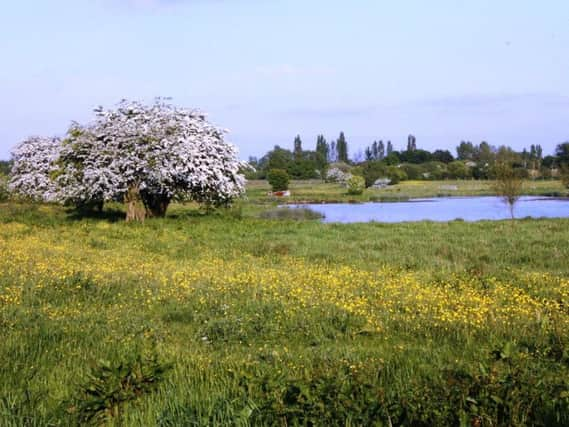Wigan green groups fear HS2 rail plan's impact on environment


As a local draft environmental consultation closed, rare peat bogs in the region appear to be under threat.
Other news: Wigan family: Kilhey Court meal shambles ruined our Christmas DayThe route of the 225mph line cuts across important mosslands, affecting wildlife networks that have taken decades to create.
Advertisement
Hide AdAdvertisement
Hide AdHS2 Ltd’s figures for the latest phase of the route, 2b, show 12 highly protected areas for nature conservation known as SSSIs, 111 local wildlife sites and 19 ancient woodlands will be damaged.
The Wildlife Trust is challenging HS2 to create and restore more wild places than are being damaged.
It also wants irreplaceable habitats, like wetlands and ancient woodlands, to be saved.
The Wildlife Trust for Lancashire, Manchester and North Merseyside believes developers must come up with answers as the line is planned to cut deep into peat bogs that are homes for wildlife and a store for carbon, which is important to keep check on global warming.
Advertisement
Hide AdAdvertisement
Hide AdLiving landscapes development manager Jo Kennedy said: “Great Manchester wetlands nature improvement area (NIA) covers an area of some 48,000 hectares between Greater Manchester and Merseyside.
“It has objectives to improve species mobility through restoring rare wetland habitats, increasing connectivity by creating stepping stones and corridors between habitats and populations and to optimise the ecosystem services provided by all habitats.
“The route of HS2 phase 2b runs roughly north to south through this landscape, directly impacting on our ability to achieve these objectives.
“HS2 will fragment the NIA, reducing the size of habitats and species populations, by the permanent creation of a physical barrier reducing the ability for species to move across the landscape to escape pressures of climate change and development, or to expand population sizes.
Advertisement
Hide AdAdvertisement
Hide Ad“There will also be temporary and permanent adverse impacts on habitats and species - loss of sites of biological importance and local wildlife sites – during construction and operation.”
The Manchester Mosses special area of conservation has the last remnants of the former extensive Chat Moss lowland raised bog complex.
Jo said: “While most of the bog in this area has been converted to agriculture or lost to development, several examples have survived as degraded raised bog.
“The largest and best preserved examples, Risley Moss, Astley and Bedford Mosses and Holcroft Moss make up the component site of special scientific interest of the Manchester Mosses SAC.
Advertisement
Hide AdAdvertisement
Hide Ad“The route of HS2 phase 2b bisects the connection between Risley Moss and Holcroft Moss.
“If the line is set on an embankment, this will create a physical barrier to species movement, resulting in habitat fragmentation and a threat to the integrity of the entire SAC. We advocate for a viaduct to be the preferred means of carrying the route across the SAC.”
The Wildlife Trust’s senior living landscapes officer Katherine Hawkins said: “It is unacceptable that HS2 has only committed to ‘no net loss’ for biodiversity, that’s not good enough, nature needs a net gain from HS2.
“Wildlife is in serious trouble, more than half of the UK’s species are in decline.
Advertisement
Hide AdAdvertisement
Hide Ad“This huge and expensive £56bn project will do yet more damage.
“We want to get the best deal for nature.
“Therefore, we’re urging HS2 to take more action to help wildlife recover by creating and restoring wild places on a landscape scale; establishing a wide ribbon of wildlife-rich spaces either side of the line, with new natural space for people and wildlife, alongside farming and other land uses.”
The proposed route through Wigan borough severs the east from the west of the great Manchester wetlands living landscape, which is an essential network of wildlife corridors and stepping stones allowing wetland habitats to thrive and survive.
It is already split north from south by the M62 and the Liverpool to Manchester railway, but HS2 will fragment it even further.
Advertisement
Hide AdAdvertisement
Hide AdThe Wildlife Trust says HS2 will create a barrier isolating populations of willow tits, the UK’s most threatened resident bird.
They are very vulnerable to loss and fragmentation of habitat, and numbers have declined by 94 per cent since the 1970s.
Large Heath butterflies and white-faced darter dragonflies are to be reintroduced, along with rare mossland plants.
Turbulence from high speed trains could affect reintroduced insect populations.
Advertisement
Hide AdAdvertisement
Hide AdRoute maps show a “satellite construction compound” next to Abram Flash SSSI, which is important for waders, waterfowl and swans.
Half of the ponds near Lightshaw Lane will be destroyed, according to the trust.
The site is of regional importance for dragonflies, damselflies, birds and amphibians.